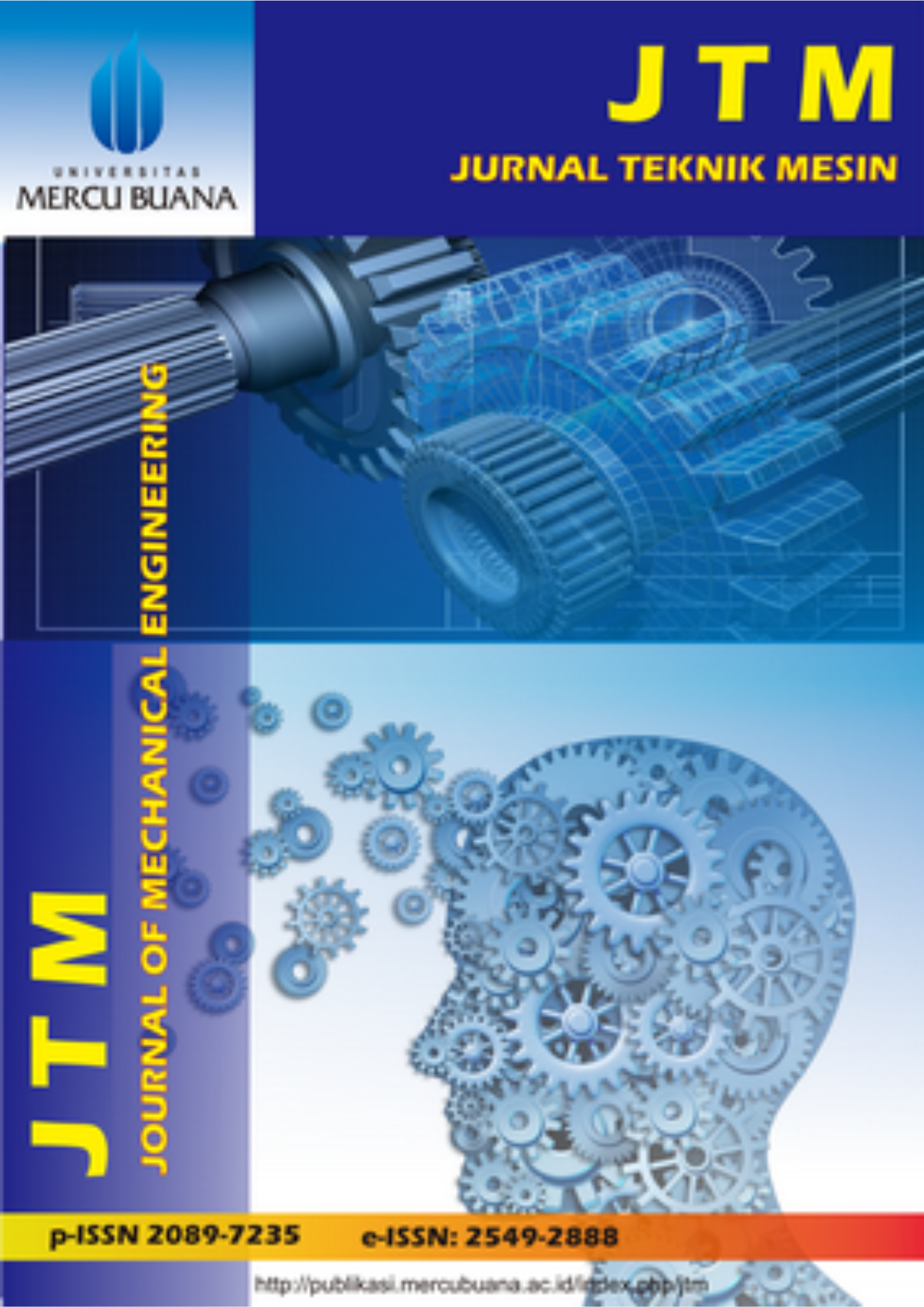PERANCANGAN ALAT POTONG SETENGAH SILINDER SEBAGAI ALAT BANTU PEMOTONG SINGKONG UNTUK BAHAN BAKU PEMBUATAN KERIPIK MANGGLENG
Abstract
Abstrak – Keripik singkong adalah jenis camilan yang dikenal luas dimasyarakat. Setidaknya, ada dua jenis keripik singkong. Hal ini dapat dibedakan dari bentuk potongan dan berdasarkan tahapan proses pengolahannya. Yang pertama keripik singkong yang sudah sangat umum dikenal dimasyarakat, yang dibuat dengan cara memotong singkong mentah (yang telah dikupas dan dicuci) secara melintang sumbu singkong dengan hasil akhir potongan berbentuk lingkaran. Dan yang kedua, keripik singkong manggleng yang dibuat dengan cara memotong singkong yang telah dikukus dengan arah pemotongan sejajar dengan sumbu singkong. Hasil akhir pemotongannya berbentuk empat persegi panjang. Untuk proses pembuatan keripik singkong jenis yang pertama, telah banyak dibuat alat bantu/mesin untuk mempercepat proses pemotongannya. Sementara untuk jenis keripik singkong yang kedua, yaitu keripik manggleng, belum ada alat bantu/mesin untuk mempercepat atau mempermudah proses pemotongan keripik singkong jenis tersebut. Secara bentuk, singkong berbentuk mendekati silinder. Perancangan ini bertujuan untuk membuat rancangan konsep alat potong dengan objek potong berbentuk setengah silinder, dengan arah pemotongan sejajar dengan sumbu silinder. Tahapan perancangan alat ini diawali dengan menentukan spesifikasi bahan baku dan hasil potongan yang diinginkan yang meliputi ukuran dan ketebalan hasil potongan. Kemudian dilanjutkan dengan pencarian alternatif konsep pemotongan, pemilihan konsep dan perancangan alat, pembuatan dokumen rancangan (gambar 2D), hingga pembuatan modeling (gambar 3D).
Kata kunci: Perancangan, keripik, singkong, manggleng, alat potong.
ABSTRACT - Cassava chips are a type of snack that is widely known in the community. There are at least two types of cassava chips. It can be distinguished from the shape of the pieces and based on the stages of the processing process. The first is cassava chips which are very commonly known in the community, which are made by cut raw cassava (that has been peeled and washed) across the axis of the cassava, with the end result being circular pieces. And the second, manggleng cassava chips which made by cut steaming cassava with the cutting direction parallel to the axis of the cassava. The final result is a rectangular cut. For the process of making the first type of cassava chips, tools/machines have been made to speed up the cutting process. Meanwhile, for the type of manggleng cassava chips, there are no tools/machines to speed up or simplify the process of cutting this types of cassava chips.
In shape, cassava is shaped close to a cylinder. This design aims is to make a design concept of cutting tool with a half-cylindrical cutting object, with the cutting direction is parallel to the cylinder axis. The tool design stage begins with determining the specifications of the raw materials and the desired cutting results including the size and thickness of the cutting results. Then proceed with the search for alternative cutting concepts, concept selection and tool design, making design documents (2D drawing), and making models (3D drawing).
Keywords: Design, chips, cassava, manggleng, cutting tools.
Full Text:
PDF (Bahasa Indonesia)References
DAFTAR PUSTAKA
Wikipedia, “Ketela pohon.” .
“HARAPANRAKYAT.COM.” https://www.harapanrakyat.com/2020/03/pelaku-ukm-produksi-manggleng-di-langensari-kota-banjar-terkendala-modal/.
P. Eradikasi and I. Helicobacter, “Proposal Program Kreativitas Mahasiswa,” 2014.
Budiyanto, “Perancangan Mesin Perajang Singkong,” J. Chem. Inf. Model., vol. 53, no. 9, pp. 1689–1699, 2013.
A. Kinematika, M. Mechanical, and T. Menggunakan, “J URNAL T eknik M esin,” vol. 12, no. 2, pp. 38–45, 2019.
T. I. M. Pengusul, “Universitas bandar lampung november 2016,” no. November, 2016.
A. Yandi, F. Azharul, V. Hadi, and P. Singkong, “Perancangan mesin pengiris singkong design of the single sliver machine,” vol. 1, pp. 41–53, 2020.
D. Natalia and U. B. L. (UBL) Jurusan Teknik Mesin, Fakultas Teknik Mesin, “Perancangan Mesin Pemotong Singkong Untuk Meningkatkan Produktivitas Pembuatan Keripik,” J. Chem. Inf. Model., vol. 53, no. 9, pp. 1689–1699, 2013.
P. Rachmawati, “Rancang Bangun Mesin Perajang Singkong yang Memenuhi Aspek Ergonomis untuk Meningkatkan Produktivitas Pekerja,” J. Engine Energi, Manufaktur, dan Mater., vol. 3, no. 2, pp. 66–72, 2019.
P. R. Yoder, D. M. Stubbs, K. A. Sawyer, and D. Aikens, Opto-mechanical design process, vol. 1. 2017.
A. Jansen and P. Slob, “Human power; comfortable one-hand cranking,” pp. 1–10, 2003.
W. Stichel, Handbook of comparitative world steel standards; USA-United Kingdom-Germany-France-Russia-Japan-Canada-Australia-International. Hrsg.: Albert & Melilli, 552 Seiten. ASTM Data Series DS 67, American Society for Testing and Materials, PA, USA 1996, £ 195.00, vol. 48, no. 6. 1997.
J. P. Vidosic, MACHINE DESIGN PROJECTS. NEW YORK: Ronald Press Co., 1957.
R. S. KHURMI, A TEXT BOOK OF MACHINE DESIGN, Third Edit. RAM NAGAR, NEW DELHI-110055: EURASIA PUBLISHING HOUSE (Pvt.) LTD., 1991.
R. S. KHURMI, STRENGTH OF MATERIALS, FIRST EDIT. RAM NAGAR, NEW DELHI-110 055: S. CHAND & COMPANY LTD., 2001.
H. Height, S. Height, and E. Height, “Human Strength Data Tables Push : Human Strength Data Tables Pull :”
L. ASAHI SEIKO CO, “Cata01_silber.pdf,” 2009. https://www.asahiseiko.co.jp/english/img/cata01_silber.pdf.
DOI: http://dx.doi.org/10.22441/jtm.v10i2.12056
Refbacks
- There are currently no refbacks.
Copyright (c) 2021 Jurnal Teknik Mesin
Jurnal Teknik Mesin (JTM)
Program Studi Teknik Mesin, Fakultas Teknik, Universitas Mercu Buana
Jl. Meruya Selatan No. 01, Kembangan, Jakarta Barat 11650, Indonesia
Email: [email protected]
Telp.: 021-5840815/ 021-5840816 (Hunting)
Fax.: 021-5871335
JTM is indexed by the following abstracting and indexing services:

This work is licensed under a Creative Commons Attribution-NonCommercial 4.0 International License.






.png)







_(486_x_90_px)_(486_x_190_px)_(486_x_190_px)_(4).png)
_(486_x_90_px)_(486_x_190_px)_(486_x_190_px)_(5).png)
2.png)
.png)
